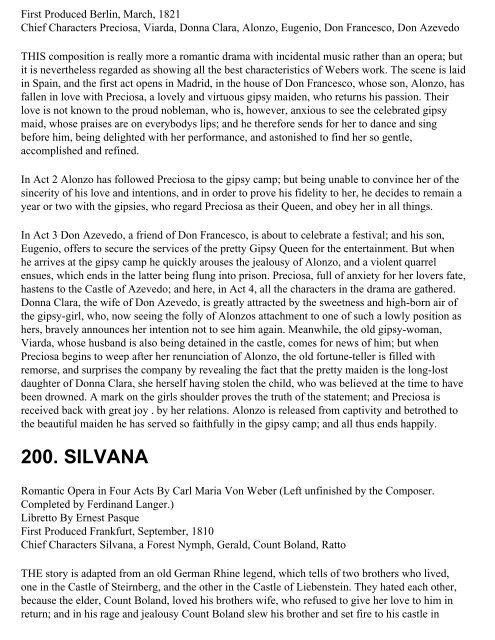Opera Plots I - MDC Faculty Home Pages
Opera Plots I - MDC Faculty Home Pages
Opera Plots I - MDC Faculty Home Pages
You also want an ePaper? Increase the reach of your titles
YUMPU automatically turns print PDFs into web optimized ePapers that Google loves.
First Produced Berlin, March, 1821<br />
Chief Characters Preciosa, Viarda, Donna Clara, Alonzo, Eugenio, Don Francesco, Don Azevedo<br />
THIS composition is really more a romantic drama with incidental music rather than an opera; but<br />
it is nevertheless regarded as showing all the best characteristics of Webers work. The scene is laid<br />
in Spain, and the first act opens in Madrid, in the house of Don Francesco, whose son, Alonzo, has<br />
fallen in love with Preciosa, a lovely and virtuous gipsy maiden, who returns his passion. Their<br />
love is not known to the proud nobleman, who is, however, anxious to see the celebrated gipsy<br />
maid, whose praises are on everybodys lips; and he therefore sends for her to dance and sing<br />
before him, being delighted with her performance, and astonished to find her so gentle,<br />
accomplished and refined.<br />
In Act 2 Alonzo has followed Preciosa to the gipsy camp; but being unable to convince her of the<br />
sincerity of his love and intentions, and in order to prove his fidelity to her, he decides to remain a<br />
year or two with the gipsies, who regard Preciosa as their Queen, and obey her in all things.<br />
In Act 3 Don Azevedo, a friend of Don Francesco, is about to celebrate a festival; and his son,<br />
Eugenio, offers to secure the services of the pretty Gipsy Queen for the entertainment. But when<br />
he arrives at the gipsy camp he quickly arouses the jealousy of Alonzo, and a violent quarrel<br />
ensues, which ends in the latter being flung into prison. Preciosa, full of anxiety for her lovers fate,<br />
hastens to the Castle of Azevedo; and here, in Act 4, all the characters in the drama are gathered.<br />
Donna Clara, the wife of Don Azevedo, is greatly attracted by the sweetness and high-born air of<br />
the gipsy-girl, who, now seeing the folly of Alonzos attachment to one of such a lowly position as<br />
hers, bravely announces her intention not to see him again. Meanwhile, the old gipsy-woman,<br />
Viarda, whose husband is also being detained in the castle, comes for news of him; but when<br />
Preciosa begins to weep after her renunciation of Alonzo, the old fortune-teller is filled with<br />
remorse, and surprises the company by revealing the fact that the pretty maiden is the long-lost<br />
daughter of Donna Clara, she herself having stolen the child, who was believed at the time to have<br />
been drowned. A mark on the girls shoulder proves the truth of the statement; and Preciosa is<br />
received back with great joy . by her relations. Alonzo is released from captivity and betrothed to<br />
the beautiful maiden he has served so faithfully in the gipsy camp; and all thus ends happily.<br />
200. SILVANA<br />
Romantic <strong>Opera</strong> in Four Acts By Carl Maria Von Weber (Left unfinished by the Composer.<br />
Completed by Ferdinand Langer.)<br />
Libretto By Ernest Pasque<br />
First Produced Frankfurt, September, 1810<br />
Chief Characters Silvana, a Forest Nymph, Gerald, Count Boland, Ratto<br />
THE story is adapted from an old German Rhine legend, which tells of two brothers who lived,<br />
one in the Castle of Steirnberg, and the other in the Castle of Liebenstein. They hated each other,<br />
because the elder, Count Boland, loved his brothers wife, who refused to give her love to him in<br />
return; and in his rage and jealousy Count Boland slew his brother and set fire to his castle in













